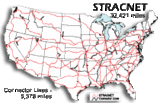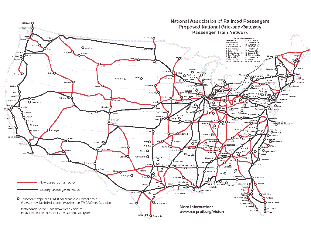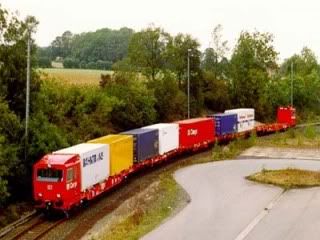(9 am. – promoted by ek hornbeck)
Burning the Midnight Oil for Living Energy Independence (also in Orange)
Joe talks about trains to the National Governors Association:
(h/t Ryan Avent, Matthew Yglesias)
Three special Federal tasks are the provision of a coast to coast system of electric trains, support for a nationwide “Rapid Rail” network, and support for inter-regional corridors providing true High Speed Rail.
If we pursue the opportunities available to use now, using existing, well tested technology, we can have a big chunk of this job finished within eight years, and can have set things in motion to see an absolute Energy Revolution in inter-regional transport in this nations by 2024.
So it may not be this Christmas, but if we hit hard on this issue, its possible for us to say, “New York, you get an electric train. Boise, you get an electric train. Detroit, you get an electric train. Atlanta, you get an electric train. Amarillo, you get an electric train. …”
More, including maps, after the fold
The Platform: Electric Rail, Coast to Coast
 The platform for this is Alan Drake’s rail electrification proposal: electrify STRACNET, the Dept. of Defense designated STrategic RAil Corridor NETwork, and strategic connecting corridors. Alan Drake presented this plan in detail at The Oil Drum (and yes, to help promote this, if you have a Digg account, do click through and Digg that post), among other places.
The platform for this is Alan Drake’s rail electrification proposal: electrify STRACNET, the Dept. of Defense designated STrategic RAil Corridor NETwork, and strategic connecting corridors. Alan Drake presented this plan in detail at The Oil Drum (and yes, to help promote this, if you have a Digg account, do click through and Digg that post), among other places.
The problems that it addresses?
- Excessive Oil Consumption by the USA, much higher than OECD average
- Economic, Energy, and Environmental costs with related National Security issues that result from excessive oil consumption
- No Real Plan to Significantly Reduce Greenhouse Gas Emissions
- Lack of Non-Oil Transportation: there are no alternatives for essential transportation that don’t use oil
- Inadequate Railroad Capacity
- Speed and reliability of today’s Rail Freight cannot compete with Truck Freight for many cargoes
- Weak Electrical Grid with limited inter-regional transmission and stability problems
- Lack of markets and transmission capacity for remote Prime Wind Farm Sites
- Chronic Under-investment in long lived, beneficial infrastructure
And the plan set out for the electrification of STRACNET:
- Electrify 36,000 miles of mainline railroads
- Expand Railroad capacity and speed by adding double tracks, better signals and more grade separation
- New 110 mph tracks for passengers and freight added to existing rail ROWs as a second step
- In many, but not all cases, use the railroad ROW as new electrical transmission line corridors
- Promote the use of rail lines, usually spur lines, as wind turbine sites with rail transported cranes and materials
- Take advantage of the lower marginal economic costs of railroads, where the more we use it, the less it costs per unit. A diffuse economic benefit for many sectors of the economy.
Now, the original plan as set out was under the constraints of the fiscal policy environment of 2006/2007, and involved packages of tax incentives and various measures to support private railroads doing as much of the investment as possible. However, with a consensus developing for a very major fiscal stimulus, its possible to move in a much more direct fashion.
- Build the electrical rail infrastructure, financed by Federal bonds, operated by a public authority, and funded by user fees paid by the carriers that use the electricity to run their trains.
This is very much, after all, like the approach to financing the Interstate Highway system that is currently relied on for the bulk of our oil-dependent freight transport. And while the Interstate Highway system had a Strategic Defense rationale in the beginning, it now contributes to National Insecurity than to National Security.
Alan Drake was able to commission professional modeling of this program, and determined that if pursued with full commercial urgency, the build out could be completed in six years. The cost that Alan Drake gives for this is $250b for a network supporting 79mph rail traffic, and $450b if the network is extended to support 110mph rail traffic (which I will discuss in more detail in the next section).
Any effort to move a substantial portion of current road freight by rail will overwhelm the current capacity of the system. However, given the current state of our rail network (and more about that in the next section as well), rail in most of the country is a decreasing cost investment … we can add capacity at a lower cost than the original capacity. A big part of this is adding track to existing corridors … double tracking rail that is single track, lengthening passing lines so that slow bulk trains can stand and wait for shorter higher speed trains to pass, increasing the power of locomotives so that freight can pass through a bottleneck more rapidly.
The flip side of having government invest in providing a lower cost energy supply that allows freight trains to run through the system more rapidly, economizing on both running costs and capital costs of rolling stock … is that the railroads receiving the rail electrification in their rail corridor must increase the freight capacity of the system, increase the capacity of the system to support 79mph through trains (both passenger and container freight), and allow available rail corridor to be used for the Rapid Rail system (next section).
 Now, consider the National Association of Rail Passengers proposal for improved Amtrak service. Compare it to the STRACNET system, and squint closely at the fuzzy little picture of STRACNET above (NB. anyone with a better picture of STRACNET, drop a link in the comments) and you will see that both existing and proposed routes would be included in the electrification of STRACNET.
Now, consider the National Association of Rail Passengers proposal for improved Amtrak service. Compare it to the STRACNET system, and squint closely at the fuzzy little picture of STRACNET above (NB. anyone with a better picture of STRACNET, drop a link in the comments) and you will see that both existing and proposed routes would be included in the electrification of STRACNET.
In other words, when I said, “Boise, YOU get an electric train, Amarillo, YOU get an electric train …”, I wasn’t joking.
As electric lines are finished, Amtrak can commission new electric trains, with new passenger cars, and start new runs. And of course, when those runs are replacing an existing run, that means that existing diesel Amtrak trains can then be used to increase frequency on parts of the network that have not yet been electrified, and new routes added to places to start filling in the expanded Amtrak route network in the NARP plan.
A Three Tier System
This is the foundation, but its not the entire house. I am going to pick up the Rapid Rail system in Part II, but first, I want to fill in some blanks about why a three tier system is needed.
At the California High Speed Rail Blog, Rafael explains this well:
In the specific case of the US, there are two major stumbling blocks. First, rail is now used primarily for slow, cheap but profitable heavy freight at interstate distances. The infrastructure is owned by competing freight companies, with some trade in trackage rights. Only a few sections of the US rail grid are publicly owned, e.g. the North East Corridor, the Caltrain SF peninsula corridor and, the Alameda freight corridor in LA. Passenger rail volume is very modest by international standards and, taxpayers have long resisted investing in something that only works well if it is perceived as a public service, rather than a commercial enterprise.
Second, the Federal Rail Administration (FRA) has defined rules that minimize overheads for heavy freight operators. Rather than spend a lot on maintenance, they just keep running a little more slowly every year. They stick with very old, winding alignments with little or no track superelevation to avoid the massive investments needed to support higher speeds. They avoid upgrades to signaling, preferring instead to rely on passive crash safety at low speeds. They do not voluntarily invest in grade separations, diesel exhaust gas aftertreatment or electrification. They even convert dual back to single track alignments and abandon underutilized rights of way altogether, because this reduces their property tax bill. They don’t stick to a timetable. The reason for all this is simple: bulk freight customers won’t pay a premium for higher speed. All of this works against the provision of effective passenger rail services, as well as regional rail freight of high value goods
Now, the STRACNET rail electrification is a substantial benefit to heavy freight, AFAIU largely because electric traction has better torque moving from a standing start than internal combustion traction. Indeed, some “diesel locomotives” in this country are diesel-electrics, where the diesel engines generate electricity which is used to drive electric motors … precisely to take advantage of that torque in getting long, heavy trains moving from a dead stop.
Its not the top speed that makes electric rail faster … its the ability to put on more power for less cost, because the electrical generating plant is not being hauled around with the train.
That is why we can expect that we can swing a deal and have private railroads competing to be the first to get the public rail electrification authority established on their existing right of way. Cutting their operating costs per ton-mile is the core of their current business model. Swapping some capital investment in capacity that they themselves can then use for trains that can complete their routes faster and cheaper, and so be turned around to do another run … there’s a deal to be found there.
However, for an effective high speed freight network, as well as a more effective passenger rail network, we cannot be bound by this operating model. We need heavy bulk freight, that is most sensitive to pure cost per ton-mile. But we also need to be able move time and schedule sensitive freight without relying on crude oil.
That is where a second tier of rail comes in … what Rafael calls (and which I shall now be calling) “Rapid Rail”. This corresponds closely to the expectations in Europe for how a normal rail line operates. Rather than relying on passive crash resistance as the front line of safety, the “UIC” standards relied on in Europe focus train control systems, signaling systems, and other measures focused on crash prevention while maintaining effective operating speeds.
When Rapid Rail is installed side by side with normal heavy freight rail, there will be three classes of trains in the system:
- Heavy freight trains, restricted to the heavy freight network. These are compliant with FRA standards, but lack the train control and other support to allow it to operated on Rapid Rail lines.
- Dedicated Rapid trains, with the train control and other support to operate safely in the Rapid Rail lines, but not compliant with FRA guidelines for operating on the heavy rail network. These will often be passenger trains, but can also include express freight carriers.
- Compliant Rapid trains, that both meet train control and other requirements for operation on the Rapid Rail lines, and comply with FRA guidelines for operation on the heavy rail network. These would include both “regular” Amtrak services, and single stacked express rail, ranging from high speed transcontinental “superfreighters” to trains like the “Cargo Sprinters” (see picture, below), specialized for shorter distances and smaller numbers of containers.

Now, the Rapid Rail system probably does require beating on some heads at the entrenched FRA (Federal Railroad Authority) … but it has the substantial benefit that it is not trying to get them to change what they are doing for the bulk of current rail operations, but rather to add a new way of doing things for a new network.
Construction of the Rapid Rail system would follow the same lines as the construction of the electrification infrastructure: in cooperation with the owners of the right of way, a public authority would finance the construction of Rapid Rail infrastructure, which would be accessed by carriers … either freight or passenger rail trains … paying user fees.
The construction of one or more Rapid Rail tracks in a right of way would be supplemented by some dedicated Rapid Rail alignments, where a new right of way can be acquired that offers electric express trains a substantial reduction in total trip time.
But, I Want High Speed Rail for Christmas! Waaaaaaaaaaaaaaaaaah!
Patience, patience, its only early in December.
I described this as a “platform” at the top of this essay. And while it directly provides support for substantially improved Amtrak passenger rail services … I have not yet described any High Speed Rail systems.
That’s what lies in store for Part II: Joe, I want a High Speed Electric Train for Christmas.
| There’s a road train going nowhere Roads are cut, lines are down We’ll be staying at the Roma Bar Till that monsoon passes on … Blue collar work it don’t get you nowhere You just go round and round in debt Somebody’s got you on that treadmill, mate And I hope you’re not beaten yet |
|

5 comments
Skip to comment form
Author
Your writings on a vision for a functional train system in this country are both entertaining and educational. And it reminds me of things people like Barry Commoner was saying 30 years ago when we could have headed this off at the pass, with much less pain. :-/
Even diesel trains pollute less than a bunch of trucks.
Back in the day–and this was long before my time–trains used to deliver goods in Manhattan. There’s a place on the old 11th Ave. el where the train went right through a building to make a delivery. IIRC, anyway–they’re turning that el into a park, but it’s been a long time since I was up there on it. (Homeless people lived there at the time: this would have been the 1980s.) (Little-known fact: that particular abandoned el track was the inspiration for Samuel R. Delaney’s The Bridge of Lost Desire. I know ’cause I asked him once at a party.)